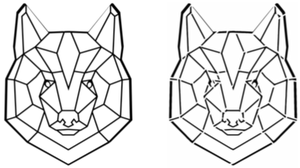Information
- Publication Type: Bachelor Thesis
- Workgroup(s)/Project(s): not specified
- Date: March 2021
- Date (Start): 2020
- Date (End): 2021
- Matrikelnummer: 01527584
- First Supervisor: Hsiang-Yun Wu
Abstract
Stencils are used as intermediate objects with designed gaps in them, to create patterns on surfaces by applying pigments on the surface through the stencil, which allows the pigment to reach the surface through the gaps and thereby to create the pattern on the surface. For the production of a stencil out of any raster image, it is not enough to assume the background color as the parts of the material that will be cut out and the other color as the material remaining in the stencil. There has to be cohesion between all the independent parts that are left in so that they do not have to be held in place individually. The needed connections between the components could be made very obvious and easy to distinguish from the intended shapes in order to draw over them later on with a paintbrush. The goal of this work however, will be an algorithm that produces connections between the shapes that can be left in the image the stencil produces, without disturbing the appearance of the shapes present (too much). This is done by finding the directions of the shapes’ contours on a vectorized version of the original image, to be able to continue in the same direction with the connections between different shapes. Then from all the possible connections the ones that will be used are found by creating a graph data structure and finding a maximum matching of that graph. In the end, it will be possible to input a binary image and get back a continuous stencil form that can be used as-is.Additional Files and Images
Weblinks
No further information available.BibTeX
@bachelorsthesis{Kompatscher-2021,
title = "Automatic Gradient-Preserving Stencilization of Raster
Images",
author = "Jan Kompatscher",
year = "2021",
abstract = "Stencils are used as intermediate objects with designed gaps
in them, to create patterns on surfaces by applying pigments
on the surface through the stencil, which allows the pigment
to reach the surface through the gaps and thereby to create
the pattern on the surface. For the production of a stencil
out of any raster image, it is not enough to assume the
background color as the parts of the material that will be
cut out and the other color as the material remaining in the
stencil. There has to be cohesion between all the
independent parts that are left in so that they do not have
to be held in place individually. The needed connections
between the components could be made very obvious and easy
to distinguish from the intended shapes in order to draw
over them later on with a paintbrush. The goal of this work
however, will be an algorithm that produces connections
between the shapes that can be left in the image the stencil
produces, without disturbing the appearance of the shapes
present (too much). This is done by finding the directions
of the shapes’ contours on a vectorized version of the
original image, to be able to continue in the same direction
with the connections between different shapes. Then from all
the possible connections the ones that will be used are
found by creating a graph data structure and finding a
maximum matching of that graph. In the end, it will be
possible to input a binary image and get back a continuous
stencil form that can be used as-is.",
month = mar,
address = "Favoritenstrasse 9-11/E193-02, A-1040 Vienna, Austria",
school = "Research Unit of Computer Graphics, Institute of Visual
Computing and Human-Centered Technology, Faculty of
Informatics, TU Wien ",
URL = "https://www.cg.tuwien.ac.at/research/publications/2021/Kompatscher-2021/",
}

 thesis
thesis

